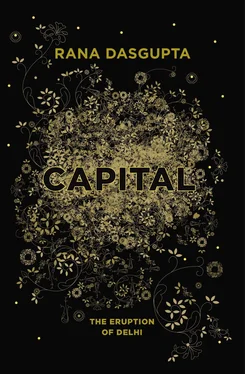Waiting at a traffic light is not empty time. On the contrary. It is in this ceasefire that the anxiety of the battlefield suddenly erupts. Drivers are racked with apprehension. They light cigarettes, curse, tap the steering wheel, honk impotently. The wait is intense and unbearable.
Finally, the lights turn to green. And at that point, the engines of the cars out front — rearing, straining, irrepressible — stall.
A furious wail of horns starts up behind them — the light is green, the promise made us is denied, it is too awful, we always knew the world would turn out to be a swindle… — until the dead engines are cranked into life once more, and the swarm moves off.
A strange kind of performance anxiety.
I once drove with an Israeli psychologist who was very disturbed by this spectacle. “ We had the holocaust,” he said. “But we don’t behave like this. We’ve put that behind us. What I see here is slave behaviour. This is survival mode. Why are they so scared they won’t get what they want?”
This is not how people drive in other Indian cities. But Delhi is a place where people generally assume — far more, say, than in Bangalore or Mumbai — that the world is programmed to deny them everything, and that making a proper life will therefore require constant hustle — and manipulation of the rules. Everyone, myself included, uses bribes and connections to get the things they need — a visa, a driving license, a quick resolution of a legal case, a place in a school, a place on a guest list — and if this city seems obsessed by status it is for good reason: power, wealth and networks deliver an immeasurably easier and better life. People who run schools and hospitals spend much of their time, not running schools and hospitals, but attending to the list of important people and their hangers-on who are haranguing them for preferential, queue-jumping treatment — which throws the systems of those places into a similar disarray as the one here on the roads. But no one wants to be just one of the anonymous mass for whom nothing ever happens. One might think that a place of inequalities as entrenched as Delhi’s would breed democratic yearnings, but it is not the case: Delhi’s fantasies are feudal. Even those who have rather little social power respect the privileges of those who have a lot — perhaps hoping that one day they will enjoy for themselves their same exemption from law and custom. Look at the advertising all around us, with its incoherent mash of mass-culture and aristocracy: this easily available consumer item will turn you into the person who never has to stop at the barriers that hold everyone else back.
Privilege dominates the roads, too. The scramble for driving opportunity is not equal. The status of people hidden behind tinted car windows may be difficult to discern accurately, but in this new era, which has overwritten previous, more indecipherable, forms of status with the single catch-all of cost , advantages accrue, quite simply, to the most expensive cars. Mercedes flash Marutis to let them through the throng, and Marutis obediently move aside. BMW limousines are so well insulated that passengers don’t even hear the unflinching horn with which chauffeurs disperse everything in their path. Canary yellow Hummers lumber over the concrete barriers from the heaving jam into the empty bus lane and accelerate illegally past the masses — and traffic police look away, for which cop is going to risk his life challenging the entitlement of rich kids? Yes, the privileges of brand rank are enforced by violence if need be: a Hyundai driver gets out of his car to kick in the doors of a Maruti that kept him dawdling behind, while young men in a Mercedes chase after a Tata driver who dared abuse them out of the window, running him down and slapping him as if he were an insubordinate kid. It is easy to see why people do not generally drive a less expensive car than they can afford. Investing in the best possible conveyance yields tangible dividends.
One may imagine where all this leaves everyone else. Cars, though ferociously dominant, transport fewer than 20 per cent of road users. The majority travel by auto-rickshaws, buses and motorised scooters. A significant proportion of urban travellers, however, navigate these packed roads on bicycles or on foot. These are overwhelmingly from the lower rungs of the economic ladder, and motor vehicles give them scant consideration; it is they, therefore, who supply the majority of Delhi’s impressive number of road deaths. For while vehicles bump into each other all the time, they are rarely travelling at speeds high enough for their passengers to sustain harm. The speeds are sufficient to do a lot of damage, however, to the ones who put their unarmoured flesh in the way of all this steel.
And for countless thousands of Delhi residents, these streets are not simply a passageway but a home, and their flesh is never far from moving vehicles.
At this hour I can already see them settling down into resting places for the night. There are the throngs of refugees from ‘development’ and ‘real estate’, the ones who lived relatively stable lives until they were displaced by the new factories and private townships of India’s boom. There are the labourers and religious pilgrims who have come to the city to conduct their business and leave again, and the ones so destitute and uprooted that they have not even been able to assemble for themselves the components of a tent. Here they sleep, in the roving glare of headlights, their heads drawn in under their blankets.
The raised central division of this busy road — the width, perhaps, of two adults — might not look like a desirable bed. But the traffic on either side keeps dogs away, and other animal disturbances. It does not of course prevent heat, cold or mosquitoes — and for the sober, the night will bring only half-sleep. The sleep that comes from never letting your attention flag. The poor can be robbed too, after all. Even the experienced pavement-sleeper can roll into the road. And if not she, then her children, who are so much more mobile when they dream.
Rickshaw drivers sleep with their vehicles. These provide some insulation, but they bring additional problems. The seat of a cycle rickshaw, while softer than a pavement, is only large enough for a torso; drivers must therefore twist their sleep around their vehicles in the most strange and gymnastic of ways. You can see them now, their feet and legs poked through railings or hoisted into ropes hanging from trees.
These itinerant masses store their personal effects in the furniture of the city. At this time of night you can see people climbing up to retrieve sacks of bedding from the roofs where they threw them in the morning. There is hardly a tree crook, hardly a concrete niche that is not stuffed with the clothes and plastic bottles of Delhi’s street dwellers. Cloth bags hang from every protrusion on every wall. Tarpaulin and bamboo poles saved from dismantled lean-tos are lashed into the tops of trees, ready for another building.
The fact that the city’s outer surfaces function as a giant bedroom, bathroom and closet for the hundreds of thousands who live in it unenclosed, helps to give the roads a run-down air. But these frayed edges — the cartoons etched on the walls by those who sleep against them, the saved-up string on nails, the blankets airing on a fence — are among the more picturesque aspects of this teeming road. For the constructions of those who run this city are just as ragged, and far more lugubrious. The road I drive on now, for instance, has recently been widened: rows of buildings on either side have had their fronts ripped off in the process, and for months this stretch has looked like a war zone. This impression is all the stronger for the fact that life does not stop in the severed rooms, as everyone driving up against them can see. Even in the upper levels, where it would be possible to fall off the floors’ hacked edge to certain death, lights are on, desks stand against walls and clerks cover their ears against the traffic to hear telephone conversations. Calendars on the walls flap in the slipstream of trucks; ceiling fans whisk the exhaust fumes of the street.
Читать дальше











